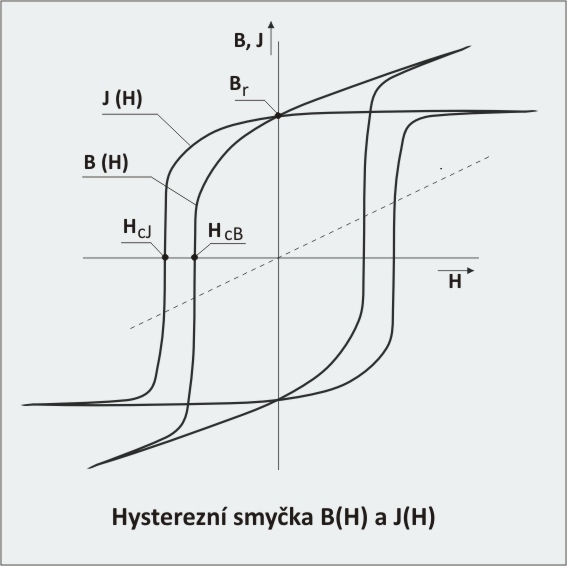Basic terminology
Magnetically hard material
Materials used for permanent magnets are referred to as a whole as "magnetically hard materials". Their basic magnetic property is an ability to retain a significant magnetic polarisation J even after the termination of the effect of an external magnetic field. The overall magnetic induction B in a material is given by the equation
B = mo . H + J
(1)
| where: | H is magnetic field intensity [ A/m ] |
| B is magnetic induction [ T ] | |
| J is magnetic polarisation [ T ] | |
| mo is vacuum permeability (4p. 10-7 Tm/A) |
The magnitude of polarisation is proportionate to the magnitude of the magnetic field:
J = mo . (mr - 1) . H
(2)
where mr is the relative permeability
Equation (1) can alternatively be written in the form
B = mo . mr . H
(3)
Hysteresis curve
The relationships J (H) or B (H) according to equations (2) or (3) characterise a magnetically hard material. The complete relationship curve from -Hmax to +Hmax and back is called the hysteresis loop. It is a reflection of the changes in the arrangement of the magnetic domains (Weiss domains) in a material. Basically, we distinguish two kinds of change: shifting of domain walls and rotation of magnetisation vectors. While the first mechanism is applied mainly in the area of lower fields, the second is important in the area of saturation. Fig.1 shows examples of both types of hysteresis curve. They differ by the additive component mo.H from equation (1). The relationship B(H) is more frequently used in technical practice, while the relationship J(H) is more useful in the field of material research.
Characteristic parameters of a magnet
A permanent magnet is usually characterised by the following basic parameters: coercivity Hc remanence Bra maximum product (BH)max.
Coercivity Hc [ A/m ] is the magnetic field intensity that acts against the direction of spontaneous magnetisation until it reaches the overall material induction B = 0. The parameter Hc is a degree of the resistance of a magnet against demagnetisation (external field and the demagnetisation proper). Remanence Br [ T ] is the value of magnetic induction which will settle after magnetisation in the closed circuit of a magnet without the action of the external magnetic field. Fig. 1 shows that while the parameter Br is identical for both curve types B(H), J(H), the same does not apply to the parameter Hc. We therefore distinguish between coercivity HcJ and coercivity HcB. The maximum product (BH)max [ kJ/m3 ] (sometimes also termed the maximum energy product) is proportionate to the magnetic energy stored in a magnet having an optimum shape. The parameter (BH)max corresponds to the interactive force of a magnet against other ferromagnetic objects (mainly iron).
| Quantity | Unit | Conversion | |
| SI | cgs | ||
| Mag. field intensity H | A/m | Oersted (Oe) | 1 A/m = 12,57.10E-3 Oe 1 kA/m = 12,57 Oe |
| Magnetic induction B | Tesla (T) | Gauss (G) | 1 T = 1 Vs/m2 = 10E4 G 1 mT = 10 G |
| Magnetic polarisation J | Tesla (T) | Gauss (G) | 1 T = 10E4 G 1 mT = 10 G |
| Magnetic flux F | Weber (Wb) | Maxwell (Mx) | 1 Wb = 1 Vs = 10E8 Mx 1 mWb = 10E 5 Mx |
| Mag. energy density w | J/m3 | G.Oe | 1 J/m3 = 1 Vs/m2. 1 A/m = 1 T.A/m 1 J/m3 = 0,1257.E3 GOe 1 kJ/m3 = 0,1257.E6 GOe |
| Vacuum permeability m | T / (A/m) | G / Oe | m = 1,257.E-6 T / (A/m) = 1,257.E-6 Vs / (Am) = 1 G/Oe |


